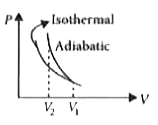A gas is compressed isothermally to half its initial volume. The same gas is compressed separately separately through an adiabatic process untial its volume is again reduced to half. Then
Compressing the gas isothermally or adiabatically will require the same amount of work.
Which of the case (whether compression through isothermal or through adiabatic process) requires more work will depend upon the atomicity of the gas.
Compressing the gas isothermally will require more work to be done.
Compressing the gas through adiabatic process will require more work to be done.
The correct Answer is:D
V1=V,V2=V/2
On P-V diagram,
Area under adiabatic curve > Area under isothermal curve.
So compressing the gas through adiabatic process will require more work to be done.

Topper's Solved these Questions
- THERMODYNAMICSBOOK - MTG GUIDECHAPTER - THERMODYNAMICSEXERCISE - NEET (ITALS)
25 Videos
- PROPERTIES OF BULK MATTERBOOK - MTG GUIDECHAPTER - PROPERTIES OF BULK MATTEREXERCISE - AIPMT/NEET (MCQs)
40 Videos
- WORK, ENERGY AND POWERBOOK - MTG GUIDECHAPTER - WORK, ENERGY AND POWEREXERCISE - AIPMT/NEET (MCQs)
34 Videos
Similar Questions
A gas is compressed isothermally to half its initial volume. The same gas is compressed separately through an adiabatic process untill its volume is again reduced to half. Then
View SolutionAn ideal gas is compressed to half its initial volume by means of several peocesses. Which of the process results in the maximum work done on the gas ?
View Solution
Knowledge Check
A gas is compressed isothermally to half its initial volume. The same gas is compressed separately through an adiabatic process untill its volume is again reduced to half. Then
ACompressing the gas through adiabatic process will require more work to be doneBCompressing the gas isothermally or adiabatically will required the same amount of workCWhich of the case(Whehter compression through isothermal of through adiabatic process) requires more work will depends upon the atomicity of the gasDCompressing the gas isothermally will require more work to be doneA gas is compressed isothermally to half its initial volume. The same gas is compressed separately through an adiabatic process untill its volume is again reduced to half. Then
AWhich of the case (whether compression through isothermal or through isothermal or through adiabatic process) requires more work will depend upon the atomicity of the gasBCompressing the gas isothermally will require more work done to be doneCCompressing the gas through adiabatic process will require more work to be doneDCompressing the gas isothermally or adiabatically will require the same amount of workA gas is compressed isothermally to half its initial volume. The same gas is compressed separately through an adiabatic process untill its volume is again reduced to half. Then
ACompressing the gas isothermally will require work to be doneBCompressing the gas through adiabatic proess is require more work to be doneCCompressing the gas isothermally or adiabatically is require the same amount of workDWhich of the case (whether compressor or through adiabatie process) requires more depend upon the atomicity of the gas.
A gas is compressed adiabatically to half its volume. By what factor does the pressure of the gas increase?
View SolutionAn ideal gas is compressed to half its initial volume by means of several peocesses. Which of the process results in the maximum work done on the gas ?
View SolutionAn ideal gas is compressed to half its initial volume by means of several peocesses. Which of the process results in the maximum work done on the gas ?
View SolutionConsider two containers A and B containing identical gases at the same pressure, volume and temperature. The gas in container A is compressed to half of its original volume isothermally while the gas in container B is compressed to half of its original value adiabatically. The ratio of final pressure of gas in B to that of gas in A is
View SolutionConsider two containers A and B containing identical gases at the same pressure, volume and temperature. The gas in container A is compressed to half of its original volume isothermally while the gas in container B is compressed to half of its original value adiabatically. The ratio of final pressure of gas in B to that of gas in A is
View Solution
